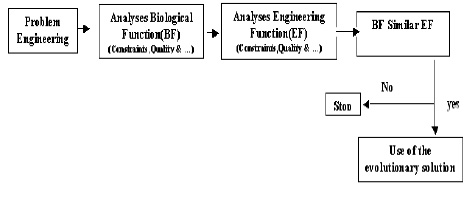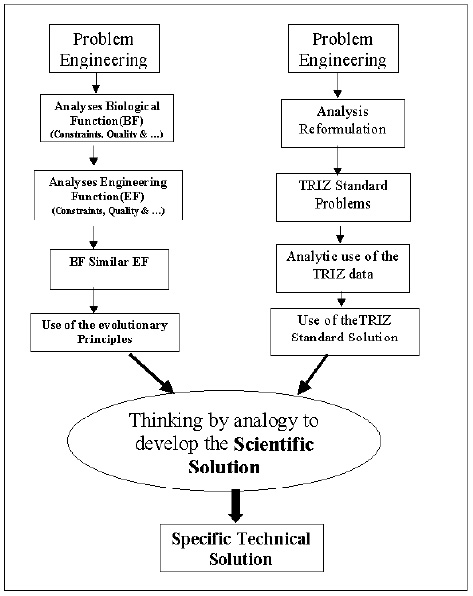Integrating TRIZ And Bionical Enginereeng

Editor | On 20, Mar 2005
Alireza Mansoorian
Department of Creativity and Innovation
Faculty of ICT, Malek Ashtar University of Technology
mansoorian@creatology-triz.com
Fatemeh Heidaryan Naeini
Azad University of Ardestan Unit
Abstract
Bionics and TRIZ are two important issues at the center of all disciplines of Science and Engineering. They also play strategic roles in the development of research and innovation. They are very powerful tools for Creative Problem Solving, Innovation, Invention, Quality Development, and Productivity in all industrials. Industries are assisted in achieving their goals through their application. In this paper, combining TRIZ with Bionics is considered and developed so that the Inventive Principles are made more effective.
Introduction
TRIZ was developed by Genrich S. Altshuller, who born in the former Soviet Union in 1926. His first invention, for scuba diving, was when he was only 14 years old. His hobby led him to pursue a career as a mechanical engineer. Serving in the Soviet (Baku) Navy as a patent expert in the 1940s, his job was to help inventors apply for patents. He found, however, that often he was asked to assist in solving problems as well. His curiosity about problem solving led him to search for standard methods. During the next few years, Altshuller screened over 200,000 patents looking for inventive problems and how they were solved. Of these (over 1,500,000 patents have now been screened), only 40,000 had somewhat inventive solutions; the rest were straightforward improvements. Altshuller more clearly defined an inventive problem as one in which the solution causes another problem to appear, such as increasing the strength of a metal plate causing its weight to get heavier. Usually, inventors must resort to a trade-off and compromise between the features and thus do not achieve an ideal solution. In his study of patents, Altshuller found that many described a solution that eliminated or resolved the contradiction and required no trade-off. Altshuller categorized these patents in a novel way. Instead of classifying them by industry, such as automotive, aerospace, etc., he removed the subject matter to uncover the problem solving process. He found that often the same problems had been solved over and over again using one of only forty fundamental inventive principles. If only later inventors had knowledge of the work of earlier ones, solutions could have been discovered more quickly and efficiently. In the recent development of TRIZ research, much effort has been put in extending TRIZ to a broader application. So far several TRIZ tools have been found to be equally effective in problem solving. Examples of this are ARIZ and the 40 Inventive Principles which have been applied in quite a few new areas such as: business (Mann, et al., 1999), quality management (Retseptor, 2003), and others. This obviously signals the viability of using TRIZ in more areas, and the promising future of TRIZ development. The general pattern of problem solving with TRIZ is shown in figure 1.
TRIZ could increase problem solving cooperation across many industries and centers. This paper introduces the Integration of TRIZ and Bionical Engineering and the effects of this integration. TRIZ are tools for engineers, researchers, managers and etc, and help them for problem solving. Bionical Engineering is modeling and inspiration of principles from nature for problem solving. Interactivity of TRIZ and Bionical Engineering is important for developed and evolution of TRIZ and increased principles of TRIZ by principles of bionics and improvement of these tools.
Bionical Engineering
Biology has had to solve engineering problems science the appearance of life on earth. Design and function in plants and animals have been optimized under evolutionary pressures over millions of years a small step at a time. These long lead times do not fit easily with the more frenetic pace of the engineering world of today but the solutions cannot be dismissed on these grounds.
Time scales may be different but design constraints and objectives are very similar: functionality, optimization and cost effectiveness. Therefore, it is not surprising that engineering has always admired biological structures and often been inspired by them, therefore we can appreciate their esthetical attributes as well as their engineering and design content.
Bionics as a scientific discipline deals with the technical transformation and application of structures, procedures and developmental principles of biological systems.
Originally, the word Bionics derives from the terms bio and technique.
Nowadays, the word is more generally used for a young and interdisciplinary research field that combines biology with the sciences of engineering, architecture, and mathematics.
Bionic: an approach for determining the aim, the method used and the solution to a problem or opportunity.
Nature, with its great variety of efficient structures, is suitable as a source for the stimulation of possible ecologically sound and ergonomic solutions to problems and opportunities.
Examples in nature can become a creative element within the process of producing a solution to a problem. The rules of biological evolution can be used both for determining the aims and the principles of functions of structures and organizations as well as providing a model for determining solutions. The Bionic approach is seen as reducing the gap between the man made world and nature. Examples are included which show how technological solutions were developed based on analogies, or models, of biological systems (example: Velcro, Eiffel Tower and etc).
Principles of nature are the abundant source of inspiration for products and materials, a futurist researcher who believes that principles of nature are worth more as a source of ideas than as a source of raw materials. Bionical engineering is innovative modeling or learning from nature. This science is a principle of design that looks at suitable solutions for human problems and problems of R&D. Using natural principles permits engineers to use that creativity in the development of: materials, design, and processes. Many older inventions are based on the study of natural mechanisms. Structures in nature that are important in the micro and macro levels are used for modeling and inspiration.
There is no strict procedure available to ensure that the correct abstraction is made or that the organism mimicked is the most suitable. This means that there is a need for a methodology to formalize the process of Bionical engineering designs that is shown in figure 2.

Integrating TRIZ and Bionical Engineering
In this section, a proposed method for the integration of TRIZ and Bionical Engineering is represented as a general model that achieves integration as a model for problem solving. This model uses all of the TRIZ tools and Bionical Engineering principles. This proposed model shown in figure 3.

This model is a powerful tool for solving of more problems.
Conclusion and prospective
A TRIZ-based methodology is developed to help the search for engineering principles for the design and technical problem solving, and limited in investment capacities. The development of the methodology is very important and Bionical Engineering could increase the ability of this. In this paper purposed The TRIZ concepts are coupled with the evolutionary principles of nature. The integrated approach of both methodology combines and a model purposed. This model is stronger of any of them, which guide the users toward the most suitable principles and existing applications. The development of this methodology is necessary. The integration of more scientific information such as the principles of nature into this methodology is believed to further nurture creativity and the generation of new principles.
References
1- Altshuller, G. S. (1984). (Genrikh Saulovich). “Creativity as an Exact Science: the Theory of the Solution of Inventive Problems†, New York: Gordon and Breach Science Publishers.
2-Domb, E. (2001). “Conference Report: Developing systematic innovation un the food industry.†TRIZ Journal, Janvier 2001, http://www.trizjounal. com/archives/2001/01.
3- Mansoorian Alireza.(2003). Bionical Creativity Engineering. Journal of Khalaghiat Shenasi , Karafrini & TRIZ . N:1 . PP : 22 .
4-Savransky, S.D.: Engineering of creativity, Introduction to TRIZ Methodology of Inventive Problem Solving, CRC Press, 2000 5-Vincent, J. F. V. and D. L. Mann (2002). “Systematic technology transfer from biology to engineering.†Philosophical transactions of the Royal Society of London Series. Mathematical physical and engineering sciences 360: 159- 173.
6-Vincent, J. F. V.(2000). Deployable Structures in Nature Center for Biomimetics, The University of Reading, U.K.
Related posts:
Support us
If you like the TRIZ Journal, please help us by donating towards domain space, admin and technical support.

